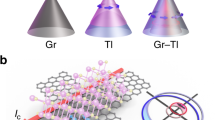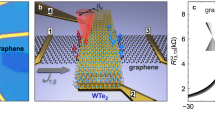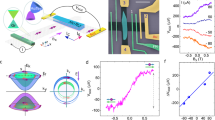Abstract
Spin–orbit coupling stands as a powerful tool to interconvert charge and spin currents and to manipulate the magnetization of magnetic materials through spin-torque phenomena. However, despite the diversity of existing bulk materials and the recent advent of interfacial and low-dimensional effects, control of this interconversion at room temperature remains elusive. Here, we demonstrate strongly enhanced room-temperature spin-to-charge interconversion in graphene driven by the proximity of WS2. By performing spin precession experiments in appropriately designed Hall bars, we separate the contributions of the spin Hall and the spin galvanic effects. Remarkably, their corresponding conversion efficiencies can be tailored by electrostatic gating in magnitude and sign, peaking near the charge neutrality point with an equivalent magnitude that is comparable to the largest efficiencies reported to date. Such electric-field tunability provides a building block for spin generation free from magnetic materials and for ultra-compact magnetic memory technologies.
This is a preview of subscription content, access via your institution
Access options
Access Nature and 54 other Nature Portfolio journals
Get Nature+, our best-value online-access subscription
$29.99 / 30 days
cancel any time
Subscribe to this journal
Receive 12 print issues and online access
$259.00 per year
only $21.58 per issue
Buy this article
- Purchase on Springer Link
- Instant access to full article PDF
Prices may be subject to local taxes which are calculated during checkout




Similar content being viewed by others
Data availability
The data that support the plots within this paper and the other findings of this study are available from the corresponding authors on reasonable request.
References
Sinova, J., Valenzuela, S. O., Wunderlich, J., Back, C. H. & Jungwirth, T. Spin Hall effects. Rev. Mod. Phys. 87, 1213 (2015).
Manchon, A., Koo, H. C., Nitta, J., Frolov, S. M. & Duine, R. A. New perspectives for Rashba spin–orbit coupling. Nat. Mater. 14, 871–882 (2015).
Soumyanarayanan, A., Reyren, N., Fert., A. & Panagopoulos, C. Emergent phenomena induced by spin–orbit coupling at surfaces and interfaces. Nature 539, 509–517 (2016).
Sander, D. et al. The 2017 magnetism roadmap. J. Phys. D 50, 363001 (2017).
Garello, K. et al. SOT-MRAM 300MM integration for low power and ultrafast embedded memories. In Proc. 2018 IEEE Symposium on VLSI Circuits Digest of Technical Papers 81–82 (IEEE, 2018).
Ganichev, S. D. et al. Spin-galvanic effect. Nature 417, 153–156 (2002).
Valenzuela, S. O. & Tinkham, M. Direct electronic measurement of the spin Hall effect. Nature 442, 176–179 (2006).
Manipatruni, S. et al. Scalable energy-efficient magnetoelectric spin–orbit logic. Nature 565, 35–42 (2019).
Manchon, A. et al. Current-induced spin-orbit torques in ferromagnetic and antiferromagnetic systems. Rev. Mod. Phys. 91, 035004 (2019).
Bibes, M. & Barthélémy, A. Oxide spintronics. IEEE Trans. Electron. Devices 54, 1003–1023 (2007).
Geim, A. K. & Grigorieva, I. V. Van der Waals heterostructures. Nature 499, 419–425 (2013).
Han, W., Kawakami, R. K., Gmitra, M. & Fabian, J. Graphene spintronics. Nat. Nanotech. 9, 794–807 (2014).
Roche, S. et al. Graphene spintronics: the European flagship perspective. 2D Mater. 2, 030202 (2015).
Novoselov, K. S., Mishchenko, A., Carvalho, A. & Castro Neto, A. H. 2D materials and van der Waals heterostructures. Science 353, aac9439 (2016).
Wang, Z., Tang, C., Sachs, R., Barlas, Y. & Shi, J. Proximity-induced ferromagnetism in graphene revealed by the anomalous Hall effect on transition-metal dichalcogenides. Phys. Rev. Lett. 114, 016603 (2015).
Leutenantsmeyer, J. C., Kaverzin, A. A., Wojtaszek, M. & van Wees, B. J. Proximity induced room temperature ferromagnetism in graphene probed with spin currents. 2D Mater. 4, 014001 (2017).
Benítez, L. A. et al. Strongly anisotropic spin relaxation in graphene–transition metal dichalcogenide heterostructures at room temperature. Nat. Phys. 14, 303–308 (2018).
Mendes, J. B. S. et al. Spin-current to charge-current conversion and magnetoresistance in a hybrid structure of graphene and yttrium iron garnet. Phys. Rev. Lett. 115, 226601 (2015).
Dushenko, S. et al. Gate-tunable spin-charge conversion and the role of spin-orbit interaction in graphene. Phys. Rev. Lett. 116, 106602 (2016).
Gmitra, M. & Fabian, J. Graphene on transition-metal dichalcogenides: a platform for proximity spin-orbit physics and optospintronics. Phys. Rev. B 92, 155403 (2015).
Gmitra, M., Kochan, D., Högl, P. & Fabian, J. Trivial and inverted Dirac bands and the emergence of quantum spin Hall states in graphene on transition-metal dichalcogenides. Phys. Rev. B 93, 155104 (2016).
Cummings, A. W., Garcia, J. H., Fabian, J. & Roche, S. Giant spin lifetime anisotropy in graphene induced by proximity effects. Phys. Rev. Lett. 119, 206601 (2017).
Ghiasi, T. S., Ingla-Aynés, J., Kaverzin, A. A. & van Wees, B. J. Large proximity-induced spin lifetime anisotropy in transition-metal dichalcogenide/graphene heterostructures. Nano Lett. 17, 7528–7532 (2017).
Garcia, J. H., Cummings, A. W. & Roche, S. Spin Hall effect and weak antilocalization in graphene/transition metal dichalcogenide heterostructures. Nano Lett. 17, 5078 (2017).
Offidani, M., Milletarì, M., Raimondi, R. & Ferreira, A. Optimal charge-to-spin conversion in graphene on transition metal dichalcogenide. Phys. Rev. Lett. 119, 0196801 (2017).
Milletarì, M., Offidani, M., Ferreira, A. & Raimondi, R. Covariant conservation laws and the spin Hall effect in Dirac-Rashba systems. Phys. Rev. Lett. 119, 246801 (2017).
Avsar, A. et al. Spin–orbit proximity effect in graphene. Nat. Commun. 5, 4875 (2014).
Kaverzin, A. A. & van Wees, B. J. Electron transport nonlocality in monolayer graphene modified with hydrogen silsesquioxane polymerization. Phys. Rev. B 91, 165412 (2015).
Wang, Y., Cai, X., Reutt-Robey, J. & Fuhrer, M. S. Neutral-current Hall effects in disordered graphene. Phys. Rev. B 92, 161411(R) (2015).
Van Tuan, D. et al. Spin Hall effect and origins of nonlocal resistance in adatom-decorated graphene. Phys. Rev. Lett. 117, 176602 (2016).
Ribeiro, M., Power, S. R., Roche, S., Hueso, L. H. & Casanova, C. Scale-invariant large nonlocality in polycrystalline graphene. Nat. Commun. 8, 2198 (2017).
Safeer, C. K. et al. Room-temperature spin Hall effect in graphene/MoS2 van der Waals heterostructures. Nano Lett. 19, 1074–1082 (2019).
Valenzuela, S. O. & Tinkham, M. Electrical detection of spin currents: the spin-current induced Hall effect. J. App. Phys. 101, 09B103 (2007).
Kimura, T., Otani, Y., Sato, T., Takahashi, S. & Maekawa, S. Room-temperature reversible spin Hall effect. Phys. Rev. Lett. 98, 156601 (2007).
Savero Torres, W. et al. Spin precession and spin Hall effect in monolayer graphene/Pt nanostructures. 2D Mater. 4, 041008 (2017).
Raes, B. et al. Determination of the spin-lifetime anisotropy in graphene using oblique spin precession. Nat. Commun. 7, 11444 (2016).
Raes, B. et al. Spin precession in anisotropic media. Phys. Rev. B 95, 085403 (2017).
Yan, W. et al. A two-dimensional spin field-effect switch. Nat. Commun. 7, 13372 (2016).
Dankert, A. & Dash, S. P. Electrical gate control of spin current in van der Waals heterostructures at room temperature. Nat. Commun. 8, 16093 (2017).
Rojas-Sánchez, J. C. et al. Spin-to-charge conversion using Rashba coupling at the interface between non-magnetic materials. Nat. Commun. 4, 1944 (2013).
Lesne, E. et al. Highly efficient and tunable spin-to-charge conversion through Rashba coupling at oxide interfaces. Nat. Mater. 15, 1261 (2016).
Rojas-Sánchez, J.-C. et al. Spin to charge conversion at room temperature by spin pumping into a new type of topological insulator: α-Sn films. Phys. Rev. Lett. 116, 096602 (2016).
Ghiasi, T. S., Kaverzin, A. A., Blah, P. J. & van Wees, B. J. Charge-to-spin conversion by the Rashba–Edelstein effect in 2D van der Waals heterostructures up to room temperature. Nano Lett. 19, 5959–5966 (2019).
Ferreira, A., Rappoport, T. G., Cazalilla, M. A. & Castro Neto, A. H. Extrinsic spin Hall effect induced by resonant skew scattering in graphene. Phys. Rev. Lett. 112, 066601 (2014).
Gebeyehu, Z. M. et al. Spin communication over 30 μm long channels of chemical vapor deposited graphene on SiO2. 2D Mater. 6, 034003 (2019).
Acknowledgements
We thank D. Torres for help in designing Fig. 1. This research was partially supported by the European Union’s Horizon 2020 research and innovation programme Graphene Flagship CORE 2, under grant agreement no. 785219; by the European Research Council under grant agreement no. 306652 SPINBOUND; by the Spanish Ministry of Economy and Competitiveness, MINECO (under contract nos FIS2015-62641-ERC, MAT2016-75952-R and SEV-2017-0706 Severo Ochoa); and by the CERCA Programme and the Secretariat for Universities and Research, Knowledge Department of the Generalitat de Catalunya 2017 SGR 827. M.T. acknowledges support from the European Union’s Horizon 2020 research and innovation programme under the Marie Sklodowska-Curie grant agreement no. 665919.
Author information
Authors and Affiliations
Contributions
L.A.B. and S.O.V. designed the device. L.A.B. and J.F.S. fabricated the device. The measurements were performed by L.A.B. and W.S.T. with the participation of J.F.S. The experimental set-up was implemented by M.T. and M.V.C., who also helped with the measurements. J.H.G. and S.R. carried out the SHE quantum simulations. L.A.B., W.S.T. and S.O.V analysed the data and wrote the manuscript. All authors contributed to the study, discussed the results and commented on the manuscript. S.O.V. supervised the work.
Corresponding authors
Ethics declarations
Competing interests
The authors declare no competing interests.
Additional information
Publisher’s note Springer Nature remains neutral with regard to jurisdictional claims in published maps and institutional affiliations.
Supplementary information
Supplementary Information
Supplementary Figs. 1–3, discussion and Table 1.
Rights and permissions
About this article
Cite this article
Benítez, L.A., Savero Torres, W., Sierra, J.F. et al. Tunable room-temperature spin galvanic and spin Hall effects in van der Waals heterostructures. Nat. Mater. 19, 170–175 (2020). https://doi.org/10.1038/s41563-019-0575-1
Received:
Accepted:
Published:
Issue Date:
DOI: https://doi.org/10.1038/s41563-019-0575-1
This article is cited by
-
Room temperature nonlocal detection of charge-spin interconversion in a topological insulator
npj 2D Materials and Applications (2024)
-
Ultralong 100 ns spin relaxation time in graphite at room temperature
Nature Communications (2023)
-
Determining spin-orbit coupling in graphene by quasiparticle interference imaging
Nature Communications (2023)
-
Berry curvature-induced local spin polarisation in gated graphene/WTe2 heterostructures
Nature Communications (2022)
-
Spin filtering effect in all-van der Waals heterostructures with WSe2 barriers
npj 2D Materials and Applications (2022)



